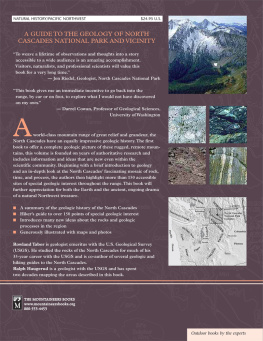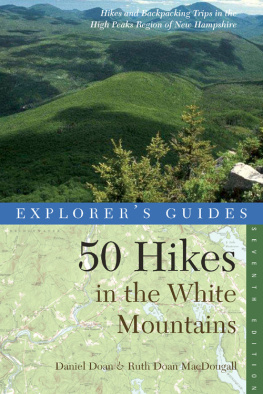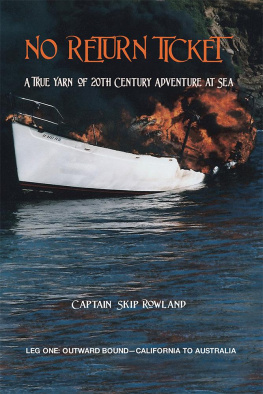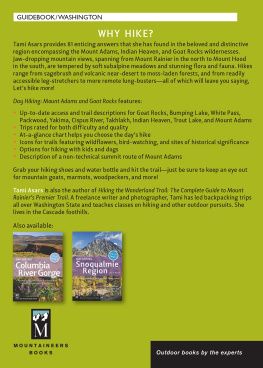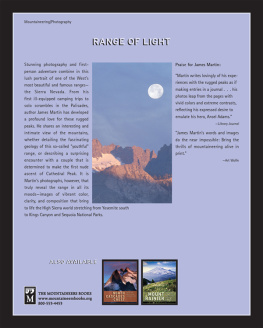

Published by The History Press
Charleston, SC 29403
www.historypress.net
Copyright 2008 by Tim Rowland
All rights reserved
First published 2008
Second printing 2013
e-book edition 2013
Manufactured in the United States
ISBN 978.1.62584.376.0
Library of Congress Cataloging-in-Publication Data
Rowland, Tim, 1960
High peaks : a history of hiking the Adirondacks from Noah to neoprene / Tim Rowland.
p. cm.
print edition ISBN 978-1-59629-541-4
1. Hiking--New York (State)--Adirondack Mountains--History. 2. Adirondack Mountains (N.Y.)--Description and travel. I. Title.
GV199.42.N652A3473 2008
796.51097475--dc22
2008038036
Notice: The information in this book is true and complete to the best of our knowledge. It is offered without guarantee on the part of the author or The History Press. The author and The History Press disclaim all liability in connection with the use of this book.
All rights reserved. No part of this book may be reproduced or transmitted in any form whatsoever without prior written permission from the publisher except in the case of brief quotations embodied in critical articles and reviews.
Contents
Acknowledgements
Great mountains seem to attract great and witty writers, past and present, and I have benefited enormously from a number of themsometimes to the point that I would forget I was supposed to be researching, and just carried on for the pure pleasure of it.
From the 1800s, Seneca Ray Stoddards arch observations and Reverend Joel Headleys drama were a treat. In more recent times, authors such as Paul Schneider, Philip Terrie and Laura and Guy Waterman have added meaningful context to the Adirondacks comparatively young history. I am grateful for their scholarship and thought.
Everywhere I went, people were happy and willing to assist with this project, despite my often-convoluted requests for information.
Tony Solomon, 46er Club historian, pointed me to the groups invaluable book, Of the Summits, Of the Forests and Paul Ertelt, communications director of the Adirondack Mountain Club, was of great help in providing history of the hiking organization.
Dick Ernenwein, a 46er and leader of international ADK treks, filled in a number of historical gaps, as did Lake Placid historian Beverley Reid.
Gail Murray and Kate Lewis of the Town of Webb Historical Association provided plenty of good information and/or photos, as did Michele Tucker and volunteers from the Adirondack Research Room of the Saranac Lake Free Library; Patricia Perez and staff of the Lake Placid Public Library; Jenifer Kuba of the Adirondack History Center Museum in Elizabethtown; Pat Galeski, archivist at the Keene Valley Public Library; and the staff of the Long Lake Public Library.
When I was just starting out, Angela Snye and Kate Moore of the Blue Mountain Lake Museum pointed me in a number of helpful directions. Jerry Jenkins of the Wildlife Conservation Society was most helpful in the area of natural phenomena, and I am indebted to the late surveyor Kermit Remele for an excellent paper he penned on the life of Verplanck Colvin.
Finally, I would like to thank my brother Bruce, who got me into hiking in the first place; Jonathan Simcosky of The History Press for his direction; and my wife Beth for her assistance in proofreading, brainstorming and offering words of encouragement like, Shouldnt you be working on your book?
Introduction
To say that one has summited Bald Mountain is a bit like saying the British conquered the Falklands. Its factual, but borders on overstatement. Bald Mountain lies like a sleeping hedgehog just north of a stretch of lakes known as the Fulton Chain outside of Old Forge, New York, in the southern Adirondacks.
The name Old Forge is accurate but misleading as well, seeing as how there was barely enough iron produced there to nail together a dog house. When I was a boy, the Adirondacks were known to our family as the Woods, and the woods were not particularly friendly to early entrepreneurial pursuits. But the name of the town stuck even if the forge didnt, and today the village is a net importer of metal, mostly in the form of the snowmobiles and pontoon boats that anchor the areas recreational foundation.
But to those who can set aside the thrills of the internal combustion engine for an hour or so, the trail up Bald Mountain still beckons, just as it did when I first climbed it in 1966. At that time, my grandpa owned a camp on Third Lake that wed visit every summer. Camp is deceptive. Almost every dwelling in the Adirondacks is known as a camp, from the lowliest shack to the grandest of mansions, including the famous Great Camps built by turn-of-the-century tycoons who were not known for their architectural humility. Our familys original camp, still standing, was an impressive-enough, two-story affair with a boathouse that they bought in the Depression for $3,000; today it would probably fetch seven figures, perched as it is on a wooded bluff overlooking the lake. That $3,000 bought a camp that was fully furnished, right down to some excellent artwork, fine china, a pump house, icehouse and servants quarters. But then, the 1930s had more than their share of motivated sellers. My family had sold off the main camp by the time I came along, but kept the servants residence, pathetic hovel that it was, with expansive screened porches and grand views of the shimmering lake.
I idolized my grandpa. Wed fish, sail and swim, and he would write me poems and make up Indian words for my activities, particularly my awkward dives off the dock, which he awarded with the Indian word of heegokerchug.

The Fisher Camp in the 1940s, which overlooks Third Lake near Old Forge and was purchased during the Depression, fully furnished, for $3,000. Courtesy of Marcy Rowland.
Hiking, as I remember in the 60s, was not the Holy Grail of leisure activities back then that it is today. But each summer, there would be the ritual climb, and our camp was an easy walk from Bald Mountains trailhead. In my family, five-year-olds were deemed too small to make the ascent, but the summer I turned six my parents and grandparents got together and decided I was ready to tackle the hike on the logic that it will get him out of the house. The trail crossed a swampy area courtesy of a couple of wooden-plank bridges and then simply went straight up the face (if I may call it the face with a straight face). This involved clamoring over several steep rock ledges, which had been helpfully affixed with steel cables to aid the climbor else add to the illusion of serious mountaineering, I dont know whichand the occasional rickety log ladder that frankly looked less safe than the ledge. I dont exactly remember who took me up, but for them it probably was less like hiking with a child than a dog. I ran all over the placeup, down, off the trail, on the trail, scrambling back down the challenging parts so I could climb them again.
Although its claim as a mountain may be tenuous, it may have been among the first ever climbed in the Adirondacks. In the late 1700s, a trapper named Nat Foster mentioned that it was nice to get up where there werent any Indians. As motivations for climbing go, some might find it dubious, but this was close to the only one there was at that time. Tourism would change that, of course, and shortly after the Civil War, surveyor Charles Grant built a camp on Third Lake that morphed into the Bald Mountain House, which was rebuilt by the Barrett family in 1893, dazzling its guests with hot and cold running water and bathtubs, another feature that would not have impressed a six-year-old boy. In the Adirondacks, trails and hotels frequently went hand in hand as guests looked around for things to do, and Bald Mountain was a popular hike for guests of the hotel.
Next page





